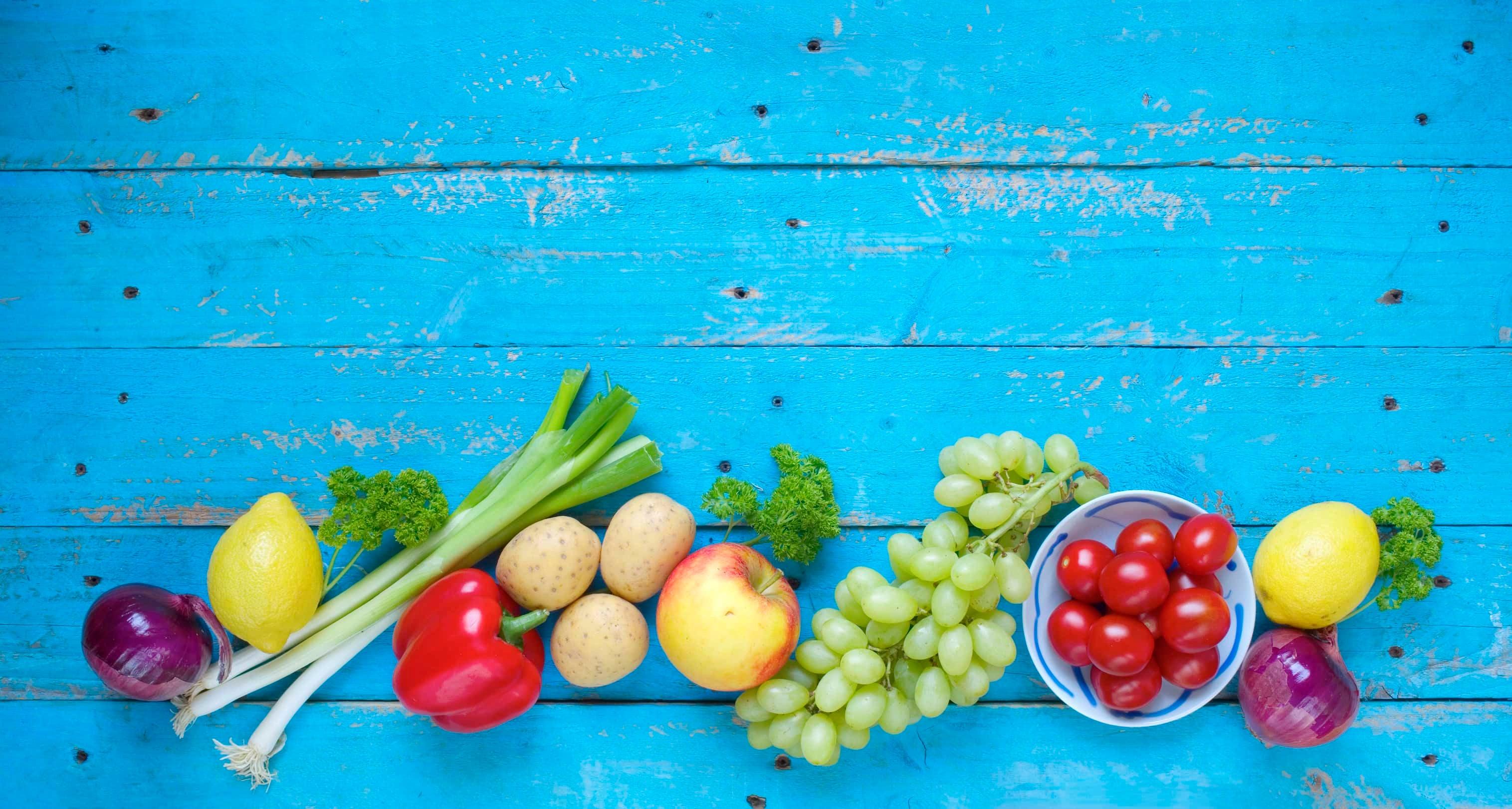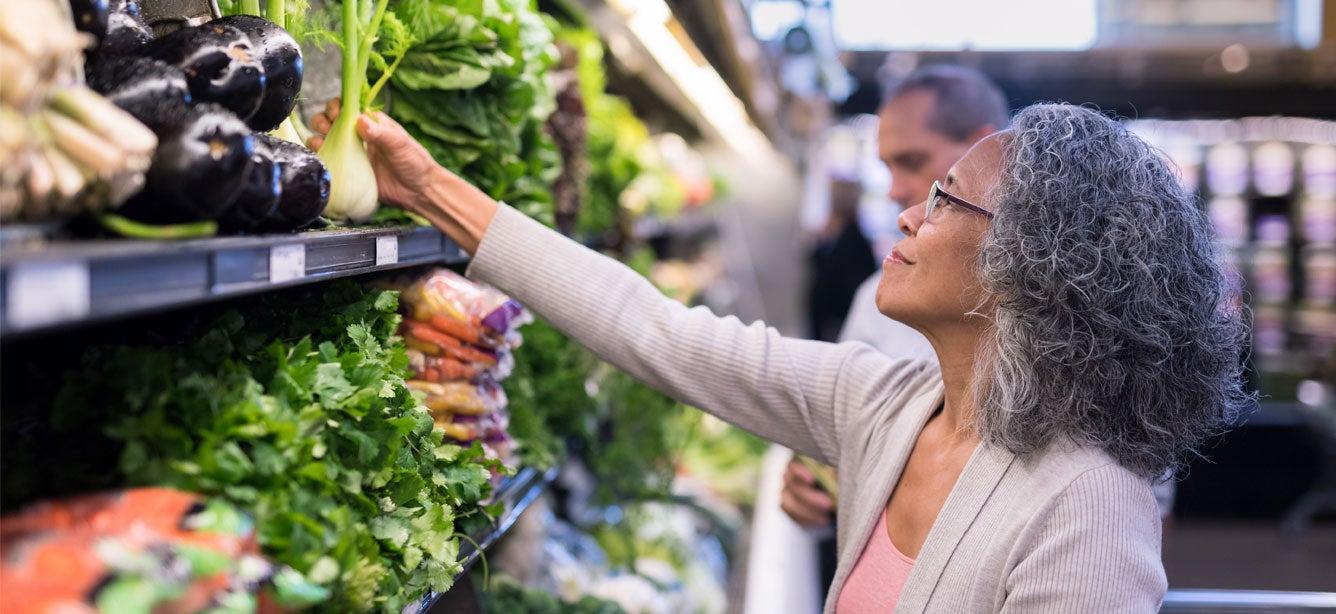
Related Topics
Rich in fiber and healthy plant compounds, fruits and vegetables are at the core of a balanced diet. These foods have been shown to reduce the risk of heart disease and stroke, lower blood pressure, prevent digestive issues, and even protect against cancer.
How many servings of fruits and vegetables should an older person eat a day?
The 2020-2025 Dietary Guidelines for Americans recommend 1.5 to 2 cup-equivalents of fruits and 2 to 3 cup-equivalents of vegetables daily for adults. In general, 1 cup of cooked or raw vegetables counts as a serving. For uncooked leafy greens (e.g., spinach), 2 cups count as a serving. For the optimal mix of nutrients, daily servings should come from each of the categories below:
- Dark green leafy vegetables
- Red fruits and vegetables
- Yellow or orange fruits and vegetables
- Legumes (beans) and peas
- Citrus fruits
For seniors, eating enough fruits and veggies is essential to staying healthy, active, and independent. This is because our nutrition needs change as we age.
If older adults don't get the nutrients they need, they’re more susceptible to malnutrition, vitamin deficiencies, and chronic diseases.
However, according to the Produce for Better Health Foundation's 2020 State of the Plate report, adults age 50 and older are eating less produce now than they were just a few years ago.
How do I get an older adult in my care to eat vegetables and fruits?
You want what’s best for your loved one or if you're a caregiver, the client you're caring for. So, what do you do when veggies and fruits aren’t their favorite fare? We've put together 10 easy ways to get more fruit and vegetable servings onto an older adult’s plate.
1. Add fruits and veggies to foods they already eat.
If the older adult you care for eats a bowl of cereal or oatmeal each morning, top it off with some chopped-up fresh strawberries or blueberries. Do they love pizza? Swap the pepperoni topping for peppers, broccoli, or tomatoes. You could even try adding vegetables to their favorite sandwich for a hearty lunch. Pre-cut varieties are an option if a senior has trouble with slicing and chopping.
“Some older adults may also have difficulties swallowing (a condition called dysphagia). That puts them at risk of choking. Serve them with fruits and vegetables that are the right size, shape, and texture. It’s also important for them to eat slowly and to chew their food well,” says Gretchen Tanbonliong, Associate Director of Health & Wellness at NCOA and a registered dietitian nutritionist (RDN). “RDNs can help plan customized meals with appropriate textures when dysphagia is a problem.”
2. Suggest a smoothie for breakfast or a snack.
If an older adult doesn't have a taste for vegetables, blended fruit smoothies are a great way to disguise the flavor. Use their favorite fruit as a base and add in a handful of spinach or kale for a green boost.
3. Buy produce that’s in season.
Fruits and vegetables look and taste their best at the peak of growing season. Your local farmers market is a good place to get the freshest, most delicious produce around. A trip to the outdoor agricultural market also gives both of you a reason to get out of the house and enjoy the nice weather. Use this as an opportunity to introduce the senior you care for to a fruit or vegetable they’ve never tried before.
4. Keep fruit in a visible place.
Place some colorful, washed, ready-to-eat fruits in a bowl on the counter, or in a clear container in the fridge. This way, they're easy to grab when the older adult you care for is having a craving for something sweet.
5. Spiralize veggies for a new “twist.”
Spiralizing involves turning a vegetable into spiral-shaped pieces. It can be easily done using an inexpensive handheld spiralizer. This gadget creates fun vegetable "noodles" that can be sprinkled over salads, used in sauces and soups, or sautéed.
6. Experiment with cooking and seasoning methods.
If an older adult has declared they don't like a certain vegetable, consider preparing it in a different way. For example, someone who doesn't care for raw zucchini sticks may enjoy zucchini grilled. Trying different herbs and spices can also make veggies more palatable.
7. “Sneak” vegetables into recipes.
There is an abundance of healthy recipes online for foods that contain "hidden" vegetables (think blueberry-beet muffins or meatloaf with collard greens). Although many of these are tailored to children, they're also ideal for older adults who struggle to meet their daily recommended intake of vegetables.
8. Keep produce-based snacks handy on the go.
When you're out and about, having healthy snacks on hand will make it easier for an older adult to make smart choices. These might include dried fruit (e.g., raisins or apricots), raw veggie sticks (e.g., carrots or celery), or any type of fresh fruit (e.g., banana or apple).
9. Make soup a mealtime staple.
Soups and stews present a golden opportunity to stock up on veggie servings. For example, Italian minestrone soup is loaded with a wide variety of vegetables and can be tailored to an individual’s specific tastes. Be sure to choose the soup product with the lowest amount of sodium you can find—or better yet, make it from scratch.
10. See if the older adult you care for qualifies for SNAP.
Fresh produce can be expensive. If your loved one or client is having trouble affording healthy food, it’s worth finding out if they’re eligible for the Supplemental Nutrition Assistance Program (SNAP). The average SNAP benefit for a one-person senior household is $188 per month,1 which can be used to buy everything from fruits, vegetables, meat, and poultry to snack foods and bottled water. If getting to the store is difficult, SNAP also covers most online grocery delivery programs, though it may not cover the delivery fee.
Still, it's clear this financial assistance is a lifeline for many older adults who may otherwise have to go without. Just ask Mark, an older adult age 66. Mark is burdened with high medical bills, which leave little money left over for food. SNAP has helped ensure he has access to healthy food.
I can now buy healthy foods and even go to local farmers markets that accept EBT. I only wish I'd known about the program sooner," Mark said.
Verifying SNAP eligibility and learning more about how to apply is simple and easy with NCOA's online tool. Just visit BenefitsCheckUp.org and enter your ZIP code to get started.
Source
1. USDA. Characteristics of Supplemental Nutrition Assistance Program Households: Fiscal Year 2023. April 2025. Found on the internet at https://fns-prod.azureedge.us/sites/default/files/resource-files/snap-FY23-Characteristics-Report.pdf




